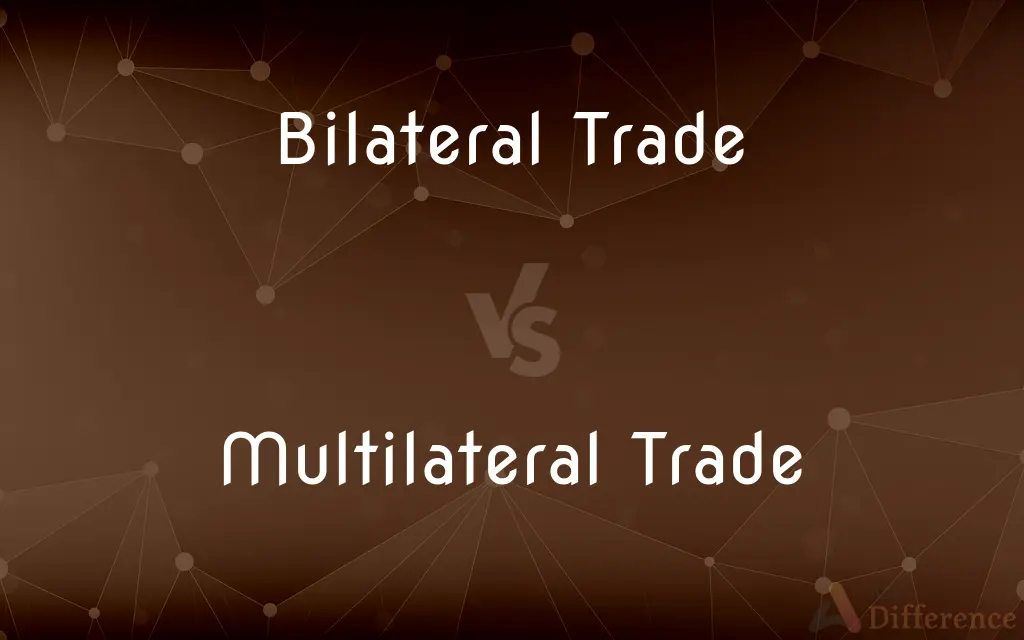Bilateral Trade vs. Multilateral Trade — What's the Difference?
By Tayyaba Rehman — Published on October 23, 2023
Bilateral Trade involves two countries trading with each other; Multilateral Trade involves multiple countries trading in a broader framework.

Difference Between Bilateral Trade and Multilateral Trade
Table of Contents
ADVERTISEMENT
Key Differences
Bilateral Trade is an arrangement between two nations, facilitating the exchange of goods and services. It often comes with agreements or treaties that reduce tariffs and foster trade specifically between the two. On the other hand, Multilateral Trade is more expansive, involving three or more nations participating in trade, usually under a collective agreement.
While Bilateral Trade is simpler and can be tailored to address specific needs and interests of the two involved countries, Multilateral Trade, being broader, requires consensus among all involved parties. The latter can be more complex due to the diverse interests of multiple nations.
Bilateral Trade agreements can be swifter to negotiate and implement since they involve only two nations. They can address specific trade barriers or challenges unique to the two nations. Conversely, Multilateral Trade negotiations might take longer due to the need to harmonize policies across many countries, but they help create a more unified global trading framework.
From a strategic perspective, Bilateral Trade agreements allow countries to gain specific advantages over competitors by negotiating preferential terms. Multilateral Trade agreements, however, foster a more inclusive trading environment, potentially benefiting a larger group of countries.
Lastly, while Bililateral Trade can sometimes lead to trade diversion (shifting trade from a more efficient supplier to a less efficient one due to favorable terms), Multilateral Trade seeks to create a level playing field, promoting efficient trade flows.
ADVERTISEMENT
Comparison Chart
Number of Parties
Two countries
Three or more countries
Negotiation Complexity
Typically simpler
More complex due to multiple parties
Strategic Advantage
Specific advantages over competitors
Level playing field for all involved
Potential for Trade Diversion
Higher
Lower
Scope
Focused on bilateral relations
Broader, often global framework
Compare with Definitions
Bilateral Trade
Bilateral Trade is trade conducted between two nations.
The Bilateral Trade agreement between the U.S. and the U.K. boosted exports.
Multilateral Trade
Multilateral Trade encompasses trade agreements among three or more countries.
Multilateral Trade talks require a consensus for successful implementation.
Bilateral Trade
Bilateral Trade pertains to trading relations exclusively between two countries.
Bilateral Trade between Canada and Mexico has seen steady growth.
Multilateral Trade
Multilateral Trade pertains to commerce involving multiple nations.
Multilateral Trade agreements can be challenging to negotiate due to diverse interests.
Bilateral Trade
Bilateral Trade signifies a two-country trading framework.
Their Bilateral Trade balance tilted in favor of country A.
Multilateral Trade
Multilateral Trade is trading activity within a broader group of countries.
Multilateral Trade dynamics shift with global economic trends.
Bilateral Trade
Bilateral Trade is commerce restricted to two participating countries.
Bilateral Trade treaties can have specific provisions benefiting both nations.
Multilateral Trade
Multilateral Trade signifies a trading framework involving numerous nations.
Their Multilateral Trade agreement benefited all participating countries.
Bilateral Trade
Bilateral Trade involves two nations exchanging goods and services.
Bilateral Trade discussions often center on tariff reductions.
Multilateral Trade
Multilateral Trade involves trade among several countries.
The World Trade Organization promotes Multilateral Trade principles.
Common Curiosities
Is Bilateral Trade easier to negotiate than Multilateral Trade?
Typically, yes, as Bilateral Trade involves only two countries, making negotiations more straightforward.
Why might countries prefer Bilateral Trade agreements?
Bilateral agreements can be tailored to the specific needs and interests of the two countries.
Can a country engage in both Bilateral and Multilateral Trade?
Yes, countries often have both bilateral agreements and participate in multilateral frameworks.
Which type of trade can lead to trade diversion?
Bilateral Trade can lead to trade diversion due to preferential terms between two countries.
Can Multilateral Trade agreements override Bilateral ones?
In some cases, yes, especially if both types of agreements have conflicting provisions.
Can Bilateral Trade lead to competitive advantages?
Yes, countries can gain specific advantages over competitors through bilateral terms.
What's the main distinction between Bilateral Trade and Multilateral Trade?
Bilateral Trade involves two countries, while Multilateral Trade involves three or more.
Why are Multilateral Trade talks lengthy?
Due to the need to harmonize policies among multiple countries with varied interests.
What is a known platform promoting Multilateral Trade?
The World Trade Organization (WTO) is a prominent platform promoting Multilateral Trade.
Is Multilateral Trade more inclusive than Bilateral Trade?
Yes, Multilateral Trade involves multiple countries, fostering a broader trading environment.
Which trade form benefits global consumers more?
Multilateral Trade, as it promotes competition and can lead to better product variety and pricing.
How does Bilateral Trade impact global trade dynamics?
Bilateral agreements can influence global trade by setting specific terms between two countries.
Do both Bilateral and Multilateral Trade have pros and cons?
Yes, both have advantages and challenges based on strategic, economic, and political considerations.
Do Multilateral Trade agreements promote globalized trade?
Yes, they create a more standardized and inclusive trading framework globally.
Are Bilateral Trade agreements more flexible?
Generally, they can be tailored to the specific interests of the two involved countries.
Share Your Discovery

Previous Comparison
Wolverine vs. Honey Badger
Next Comparison
Mohawk vs. FohawkAuthor Spotlight
Written by
Tayyaba RehmanTayyaba Rehman is a distinguished writer, currently serving as a primary contributor to askdifference.com. As a researcher in semantics and etymology, Tayyaba's passion for the complexity of languages and their distinctions has found a perfect home on the platform. Tayyaba delves into the intricacies of language, distinguishing between commonly confused words and phrases, thereby providing clarity for readers worldwide.
















































